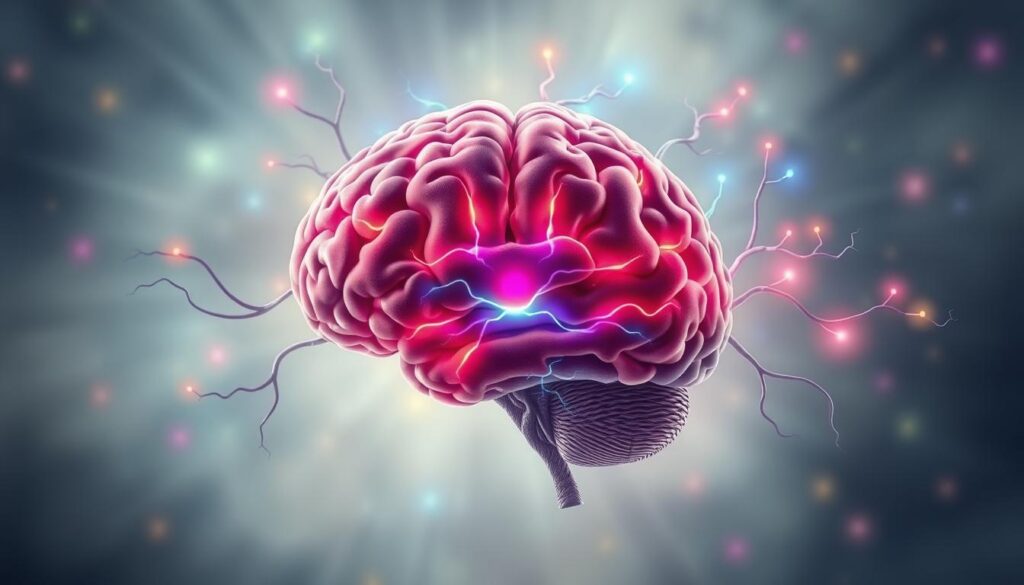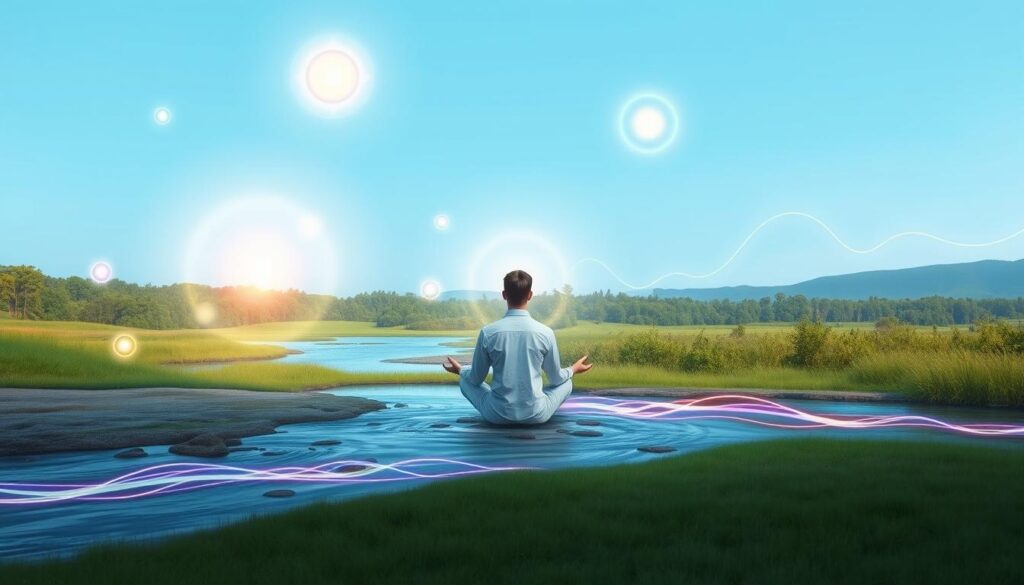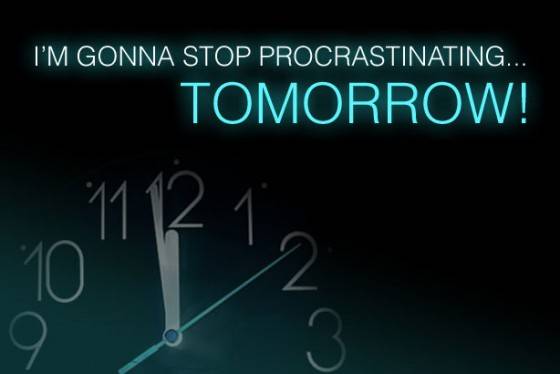“The greatest weapon against stress is our ability to choose one thought over another.” – William James, American philosopher and psychologist.
Stress is a natural part of life, but it doesn’t have to control us. In today’s fast world, managing stress is key for our health. Visualization is a powerful way to find peace and calm.
Visualization, or guided imagery, lets you imagine peaceful places or positive outcomes. By using your senses and imagination, you can relax deeply. This reduces stress and helps you handle life’s challenges better.
Key Takeaways
- Stress can harm our physical and mental health.
- Visualization is a strong tool for managing stress and finding peace.
- Using your senses and imagination can lessen stress symptoms.
- Regular visualization practice can improve your mental health over time.
- Visualization can be added to your daily routine for stress relief.
Understanding the Brain’s Response to Stress
To manage stress well, we need to know how our brain reacts to it. The amygdala, a small part of the brain, is key in this process. It starts the fight-flight-freeze response, making our heart race and releasing stress hormones.
The Role of the Amygdala in Stress Response
The amygdala checks for threats and decides how to react. When it finds a threat, it quickly sends signals to the brain stem. This leads to the body’s fight-flight-freeze response. But, constant stress can harm our health over time.
How Chronic Stress Affects Mental Health
Long-term stress is bad for our minds. It can lower the production of GluA1, a protein needed for brain communication. This can lead to anxiety, depression, and problems with thinking.
The Connection Between Mind and Body
Stress affects our body as much as our mind. It can raise blood pressure, weaken our immune system, and cause stomach problems. It’s important to see how our mind and body are connected to manage stress better.

“Visualization may help cope with negative thought patterns by disrupting them and can promote neuroplasticity over time.”
The Science Behind Visualization Techniques
Visualization techniques help you focus on calming images instead of stress. This engages your senses and can make your body relax. Regular use can change your brain, helping you manage stress better over time.
Research shows daily visualization can lower stress and boost happiness. It helps control emotions, reduces stress signs, and makes you feel more relaxed and happy.
Visualization changes how your body reacts to stress. It lowers stress hormones and increases happy chemicals like dopamine and serotonin.
Positive visualization also sharpens your mind, improves focus, and boosts self-confidence. Imagining success can build confidence and drive.
It also strengthens your immune system, helps with pain, and improves overall health. Regular practice can help you reach your goals and feel better overall.
| Benefit | Impact |
|---|---|
| Emotional Regulation | Reduces physiological stress response and increases feelings of relaxation |
| Concentration and Productivity | Trains the brain to focus on specific imagery, reducing mind-wandering |
| Self-Esteem and Confidence | Helps individuals imagine themselves succeeding, leading to increased confidence |
| Pain Management | Shifts focus away from pain, providing temporary relief |
| Immune Function | Stimulates the production of immune-boosting substances like interleukins and lymphocytes |
| Relaxation and Well-being | Triggers the release of stress-reducing hormones and “feel-good” neurotransmitters |
The science is clear: visualization boosts your mental, physical, and emotional health. Regular use can help you achieve your goals and feel more relaxed and adaptable.

Stress Management Through Visualization: Core Principles and Benefits
Visualization is a strong tool for stress relief and reducing anxiety. It helps improve mental and physical health. This practice uses your mind to bring quick relief and long-term benefits.
Immediate Benefits of Guided Imagery
Guided visualization changes your brain in ways that feel real. It quickly lowers anxiety and stress. Imagine a calm place, like a beach or forest, to relax your brain.
This activates your brain’s reward system. It releases happy chemicals like dopamine and serotonin. These chemicals help reduce stress and anxiety, making you feel calmer.
Long-term Effects on Mental Well-being
Regular visualization improves your mental health over time. It helps you manage stress and anxiety better. Studies show it boosts self-compassion and mindfulness.
By making visualization a part of your routine, you gain control over your thoughts and feelings. This leads to better mental health.
Physical Health Improvements
Visualization also benefits your physical health. It can reduce muscle tension, lower blood pressure, and boost your immune system. Visualizing your body relaxed and healthy can help your body feel better.
Visualization is a powerful way to manage stress. It offers quick relief and long-term benefits for your mind and body. Adding it to your daily routine can help you handle life’s challenges better.
Getting Started with Visualization Practices
In these tough times, guided imagery exercises, relaxation techniques, and mindfulness practices are key for stress and anxiety management. The COVID-19 pandemic has made our lives uncertain and uneasy. It’s vital to find ways to cope with this.
To start with visualization, find a quiet, comfy spot without distractions. Take deep breaths to relax and calm your mind. Then, pick a peaceful scene or positive outcome to imagine.
Use all your senses – sight, sound, smell, touch, and taste – to make your imagery vivid. This will help you feel more immersed in your visualization.
Try to visualize for 5-15 minutes each day. As you get better, increase the time. Being consistent is crucial for mastering visualization for stress relief. Studies show regular practice can greatly improve your mental health, like reducing anxiety and boosting mood.
Visualization isn’t about escaping reality but finding calm in your mind. By practicing these mindfulness practices, you can better control your emotions, focus, and find peace. These skills are very useful for today’s challenges.
“Visualization is the ability to create pictures in your mind and to use those pictures to achieve your goals.”
– Denis Waitley
Explore the power of visualization to manage stress and find balance in your life. With effort and patience, these relaxation techniques can become a big part of your mental health arsenal.
Advanced Visualization Techniques for Deep Relaxation
To get the most out of visualization for deep relaxation, try more than just basic images. Use advanced techniques to create a safe space just for you. This can include using your senses and adding muscle relaxation for a better experience.
Creating Your Personal Safe Space
Imagine a peaceful, private place that feels just right for you. It could be a quiet beach, a snug cabin in the woods, or any other spot that brings you calm. Add lots of details, like what you see, hear, and feel. The more real your mental retreat, the better it will help you relax.
Multi-sensory Visualization Exercises
Use all your senses to make your visualization more real and relaxing. Think about the sounds, smells, tastes, and feels of your safe space. For instance, picture the sound of waves, the smell of flowers, or the warmth of the sun. This way, you’ll feel more relaxed and fully immersed in your mental getaway.
Progressive Relaxation Integration
Combine visualization with progressive muscle relaxation for even more relaxation. Start by tightening and then relaxing each muscle group. Imagine your safe space while doing this. This mix of mind and body can lead to deep relaxation.
Adding these advanced visualization techniques to your stress relief routine can bring you mental peace and physical health. Try different methods to find what works best for you.
Incorporating Visualization into Daily Routine
Adding daily stress management techniques like visualization to your routine is crucial. Set aside times, like when you wake up or before bed, to practice. This way, visualization becomes a regular part of your day.
Short breaks for visualization can help manage daily stress. Just a few minutes of closing your eyes and imagining a peaceful scene can help. It can help you focus better and feel less tense, making your day easier to handle.
If you’re always on the go, use visualization during activities like commuting or exercising. As you do these things, imagine your goals or just relax. This makes your mindfulness practices more effective.
Being consistent is key to using visualization as a stress tool. The more you practice, the easier it becomes. It helps you deal with life’s ups and downs better.
| Visualization Technique | Suitable Time for Practice | Potential Benefits |
|---|---|---|
| Guided Imagery | Morning, Bedtime | Reduces stress, Promotes relaxation |
| Positive Affirmations | Throughout the Day | Boosts confidence, Enhances focus |
| Mental Rehearsal | Before Challenging Tasks | Improves performance, Builds resilience |
| Creative Visualization | Any Quiet Moment | Sparks creativity, Promotes well-being |
Find the visualization method that fits you best. Try different techniques and times to see what works for you. With regular practice, visualization can become a strong ally in managing daily stress and building your routine.
Combining Visualization with Other Stress Relief Methods
Boosting your visualization practice means mixing it with other stress-busting methods. Adding mindfulness, meditation, breathing, and exercise can make your relaxation deeper and more effective. This mix can lead to greater calm and well-being.
Mindfulness and Meditation Synergy
Mindfulness and meditation pair well with visualization for stress management. These practices help you relax and stay in the moment. Begin with a guided meditation, then dive into a visualization of a safe space or a positive future.
Breathing Exercises Enhancement
Breathing techniques complement visualization nicely. Deep breathing calms your mind and body, making visualization more effective. Try pairing visualization with diaphragmatic or 4-7-8 breathing for even more relaxation.
Physical Activity Integration
Adding visualization to your exercise routine is a great stress relief strategy. Imagine yourself doing a yoga flow or a brisk walk well. This mix of movement and mental images boosts motivation and well-being.
| Stress Relief Method | Benefits of Combining with Visualization |
|---|---|
| Mindfulness and Meditation | Deepens relaxation response, enhances present-moment awareness |
| Breathing Exercises | Amplifies calming effects, promotes deeper state of relaxation |
| Physical Activity | Boosts motivation, focus, and mind-body connection |
Combining these stress relief methods with visualization unlocks its full potential. Try different mixes to find what works best for you. This approach leads to a more complete holistic stress management experience.
Overcoming Common Visualization Challenges
Using visualization techniques daily can help with stress management and growth. Yet, you might face challenges like concentration issues, keeping up with consistent practice, and creating clear mental images. Don’t give up – with effort and the right methods, you can beat these hurdles and enjoy visualization’s benefits.
If concentration is hard, try guided visualizations or use photos or videos. These tools can keep your focus and guide you. As you get better, try longer sessions without these aids, helping your mind stay focused.
Keeping up with consistent practice can be tough, especially when life is busy. Make visualization a part of your daily life, whether it’s a quick 5-minute session in the morning or a longer one before bed. Find the best time and place for you.
If you have aphantasia, don’t worry. Visualization can still help. Focus on sounds, touch, or smells instead of visuals. You can also try other relaxation methods like progressive muscle relaxation or mindfulness meditation.
The secret to beating visualization challenges is practice consistency. Begin small, be kind to yourself, and celebrate small wins. With time and effort, you’ll see how visualization can boost your concentration and well-being.
“Visualization is the first step in creating the future you desire.”
– Oprah Winfrey
Conclusion
Visualization is a strong tool for managing stress. It can greatly improve your mental and physical health. By using your mind, you can handle stress better, stay motivated, and reach your goals.
Regular use of visualization can make you more resilient to stress. It also helps you feel emotionally stable and peaceful inside. This practice can change your life for the better.
If you want to reduce daily stress or improve your mental health, try visualization. It works well with other stress-reducing activities like mindfulness and exercise. This way, you can manage stress better and live a happier life.
Remember, you have the power to handle stress and achieve your dreams. Use visualization to unlock your mind’s full potential. This will help you live a healthier, more balanced, and fulfilling life.
FAQ
What is the role of the amygdala in the brain’s stress response?
The amygdala is a small part of the brain that handles stress. It triggers the fight-flight-freeze response. This response makes your heart beat faster and changes how you breathe.
How can visualization techniques help with effective stress management?
Visualization helps by focusing your mind on calm images instead of stress. It uses your senses to relax your body. This can make you feel less anxious and more calm over time.
What are the immediate and long-term benefits of practicing visualization for stress management?
Right away, visualization can make you feel less anxious and more relaxed. Over time, it can improve your mental health and emotional control. It can also make your body healthier by lowering blood pressure and boosting your immune system.
How can I get started with visualization practices for stress management?
Start by finding a quiet, comfy spot without distractions. Begin with deep breathing to calm down. Pick a peaceful scene or positive outcome to imagine, using all your senses.
Practice for 5-15 minutes each day, slowly increasing the time. Being consistent is important to get better at using visualization to manage stress.
What are some advanced visualization techniques for deeper relaxation?
For deeper relaxation, try creating a personal safe space in your mind. Use exercises that engage all your senses for a more real experience. Adding progressive muscle relaxation to your visualization can make it even more effective.
How can I incorporate visualization into my daily routine?
Make visualization a part of your daily life by setting aside time for it. Practice it when you wake up or before bed. Use short breaks during the day to handle stress. Mix it with other daily activities like driving or working out.
Being consistent helps make visualization a regular way to manage stress.
How can I overcome common challenges with visualization practices?
Challenges like focusing, keeping up with practice, and vivid images are common. Start with guided visualizations and use pictures or videos to help. Slowly increase how long you practice.
If you can’t imagine things, focus on other senses or try different relaxation methods.




























































